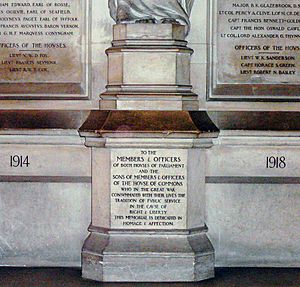Parliamentary War Memorial facts for kids
The Parliamentary War Memorial is a special stone sculpture. It's also called the Recording Angel Memorial. You can find it in Westminster Hall in London. This memorial was first shown in 1922. It remembers all the people from the House of Commons and the House of Lords who died in the First World War.
The memorial lists 22 members from the House of Commons and 20 from the House of Lords. It also includes 9 important staff members. Plus, it names 94 sons of members and officers from the House of Commons who lost their lives. (Sons of peers and House of Lords staff are remembered on wooden panels in the Royal Gallery). Above this memorial, a big stained glass window honors those from both Houses who died in the Second World War.
Contents
History of the Memorial
Planning for the Parliamentary War Memorial started in July 1917. A special committee chose a spot under a large gothic window. This window is in St Stephen's Porch, at the south end of Westminster Hall. They asked different artists to design the memorial.
Creating the Design
The design by an Australian artist named Bertram Mackennal (1863–1931) was chosen. He changed an old Victorian screen. He added the main parts you see today. These include a winged figure, like an angel writing things down. This figure is called the "recording angel." On each side of the angel, there are two curved panels. These panels hold the names of those who died.
Mackennal's design also had a small dome, called a cupola, above the angel. It had a gothic arch and small bronze statues. These statues were of the patron saints of England, Scotland, Ireland, and Wales. The two panels and the angel were made from Portland stone. They were put into the older screen in 1921.
Adding More Names
In 1922, some changes were made. Six more panels were added, three on each side. These new panels were for the names of the sons of Members of Parliament (MPs) and House of Commons officers who died. Columns now stand between the central part and these new side sections. Each column has a shiny bronze statue on top. One statue shows "Faith" and the other shows "Fortitude" (meaning strength).
Edward, Prince of Wales, who later became Edward VIII, officially showed the bigger memorial in 1922.
Damage and Repair
The memorial was damaged during the Second World War. On September 27, 1940, a bomb hit nearby. It blew a hole in the window above the memorial. Parts of the window fell onto the memorial. The cupola (the small dome) was knocked off. The angel's feet broke, and some name panels came loose.
There were ideas to make the memorial bigger for those who died in the Second World War. But instead, a new stained glass window was made. This window now remembers members and staff from both Houses who died in that war. Sir Ninian Comper designed the new window. It shows service badges and symbols for 22 MPs, 34 Peers, and 5 staff members.
After fixing the building, the memorial was repaired starting in 1951. The cupola was not put back. This was so it wouldn't block the view of the new window. The bronze statue of St Andrew from the cupola is now in the Parliamentary Art Collection. However, the statues of St George, St Patrick, and St David are now missing.
In 2018, a former MP named Gerald Arbuthnot was added to the memorial. He died during the Battle of the Somme. His name had been accidentally left off for 96 years.
Other Memorials in Parliament
There are other war memorials inside the Houses of Parliament. These include:
- Special books of remembrance for both the House of Commons and the House of Lords.
- A memorial for other staff members in Chancellors Court.
- A memorial for journalists who worked in Parliament, found in the Press Gallery.
- 42 special shields in the House of Commons. Each shield honors an MP who died while serving in the World Wars.
- Shields above the entrances of the Commons Chamber. These honor Airey Neave and three other MPs. They were killed by groups called the Irish Republican Army and the Irish National Liberation Army.


